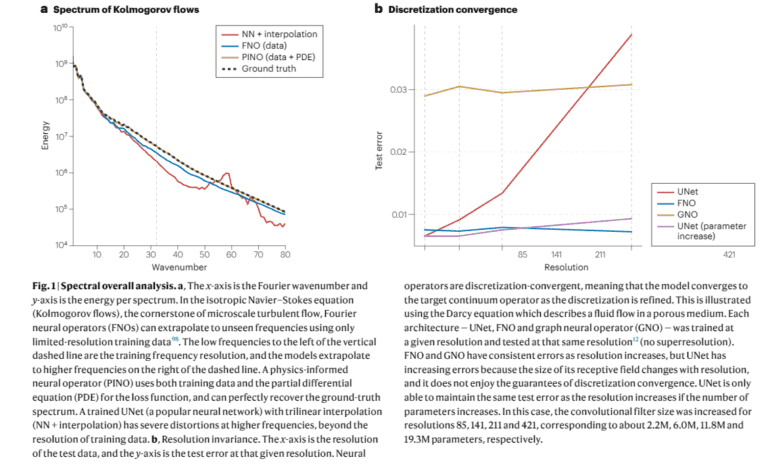- AI-driven neural operators redefine scientific simulations, offering a swift and cost-effective alternative to traditional methods.
- NVIDIA and Caltech collaborate to introduce neural operators, enhancing modeling efficiency for complex systems.
- Operators like FNO and PINO optimize predictions across various resolutions and ensure compliance with physical laws.
- Significant improvements include a 45,000x speedup in weather forecasting accuracy and a 26,000x increase in fluid dynamics simulation speed.
- PINO achieves remarkable accuracy, matching ground-truth spectra with minimal test errors.
- Zero-shot super-resolution capabilities enable predictions beyond training data limits.
Main AI News:
Cutting-edge artificial intelligence is reshaping the landscape of scientific exploration and engineering innovation, offering a rapid and cost-effective alternative to traditional experimental methods. Among these advancements, neural operators stand out, revolutionizing the approach to complex problems that defy conventional numerical simulations. These challenges often involve dynamic systems that strain computational resources and demand extensive data inputs.
The current bottleneck in scientific and engineering simulations lies in the limitations of traditional numerical techniques. These methods, reliant on computational grids to solve partial differential equations, are sluggish and struggle to integrate high-resolution data effectively. Moreover, they often fail to extend beyond the specific conditions of their training data, restricting their real-world applicability.
Pioneering research has explored various avenues, from finite element methods in fluid dynamics to the application of machine learning in dynamical systems. Convolutional neural networks and transformers have shown promise in processing visual and textual data, yet they struggle with continuous scientific datasets. Enter Fourier neural operators (FNO) and Graph Neural Operators (GNO), which excel in capturing global dependencies and non-local interactions, while Physics-Informed Neural Operators (PINO) incorporate physical constraints to enhance predictive accuracy.
In a groundbreaking collaboration, researchers from NVIDIA and Caltech have introduced a game-changing solution: neural operators that significantly amplify the efficiency of modeling complex systems. This innovative approach capitalizes on the continuity of functions across domains, enabling predictions beyond the confines of discrete training data. By integrating domain-specific constraints and employing a differentiable framework, neural operators empower direct optimization of design parameters, showcasing adaptability across diverse applications.
Central to this methodology are neural operators, particularly FNO and PINO, which operate on continuously defined functions, enabling precise predictions across varying resolutions. FNO, operating in the Fourier domain, streamlines global integration, while PINO ensures compliance with physical laws through physics-based loss functions derived from partial differential equations. Leveraging datasets like the ERA-5 reanalysis dataset, the model achieves remarkable predictive accuracy and generalizability, even when extrapolating beyond training data scopes.
The impact of these neural operators on scientific simulations is profound. For instance, FNO has accelerated weather forecasting accuracy by an astonishing 45,000 times, while enhancements in computational fluid dynamics have led to a 26,000-fold increase in simulation speed. PINO has demonstrated exceptional accuracy, matching ground-truth spectra with test errors as low as 0.01 at previously unobserved resolutions. Furthermore, it enables zero-shot super-resolution capabilities, predicting higher frequency details beyond the training data’s limits. These results underscore the transformative potential of neural operators in dramatically improving simulation efficiency and accuracy across diverse scientific domains.
Conclusion:
The collaboration between NVIDIA and Caltech in advancing neural operators for scientific simulations heralds a new era of efficiency and accuracy. This breakthrough not only enhances existing capabilities but also opens doors for innovative applications across multiple industries, promising transformative impacts on the market for simulation software and AI-driven solutions.

